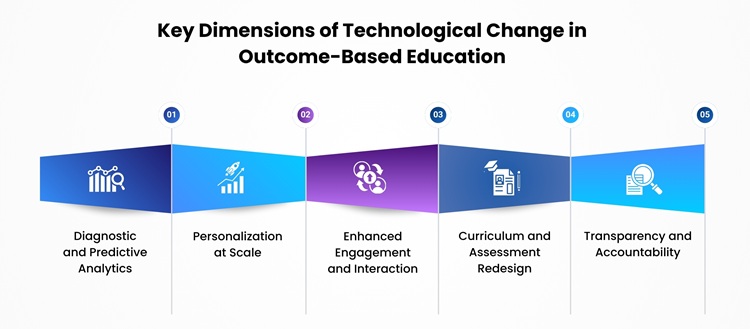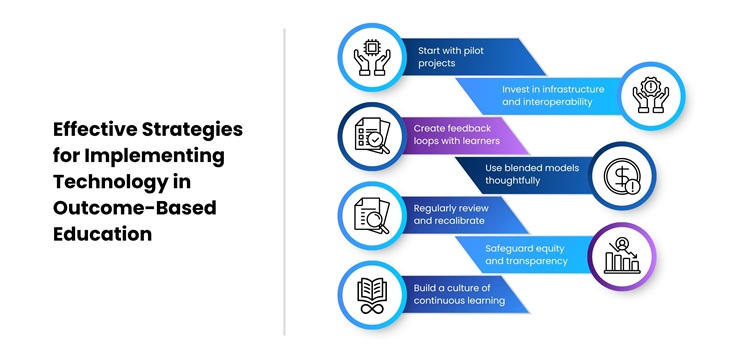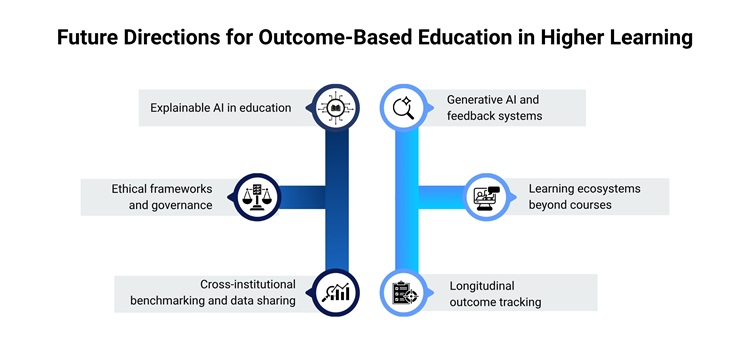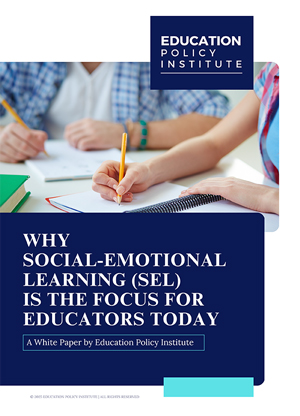In recent years, higher education has witnessed a shift toward outcome-based education (OBE), a model that centers on clearly defined learning goals, competencies, and student achievement. Against this backdrop, technology is playing a transformative role. It is reshaping instruction, assessment, feedback, and institutional practices in ways that allow outcome-based systems to become more robust, data-driven, and responsive. As institutions adopt digital tools, they face both opportunities and challenges in ensuring that the future they build supports access, equity, and meaningful learning outcomes.
Technology’s Role in Advancing Outcome-Based Education
Outcome-based education emphasizes explicit statements of what students should be able to do once they complete a course or a program. Traditional teaching models, often focused on content delivery, can miss whether students truly master those outcomes. Technology introduces mechanisms to better align teaching efforts with desired outcomes by enabling continuous measurement, adjustment, and support.
First, learning management systems (LMS) with analytics provide real-time insights into student performance. By tracking assignments, quizzes, forum participation, and login patterns, these systems help educators identify which students are lagging or which content modules are underperforming. This capability supports adaptive course corrections. Second, interactive tools like simulations, virtual labs, augmented or virtual reality, allow learners to practice complex skills in controlled settings that mimic real contexts. Students can experiment, fail safely, and repeat until mastery. Third, assessment platforms offer varied and frequent testing modes (formative quizzes, embedded checks, peer review) that help monitor progress continuously, rather than relying solely on high-stakes finals. Fourth, digital feedback loops through automated grading, comment systems, and dashboards accelerate the feedback process, allowing learners to adjust strategies before final evaluation.
In the context of higher education, these tools can strengthen connections between curriculum design, instructional delivery, and student outcomes. Through regular monitoring and modulation, instructors can refine pacing, scaffold support, or reallocate time to concepts that prove difficult in real time.
Key Dimensions of Technological Change in Outcome-Based Education
To see how technology is transforming education, we can look at the main areas where it makes an impact:

1. Diagnostic and Predictive Analytics
By collecting multiple data streams such as grades, attendance, engagement metrics, and other behavioral signals, institutions can develop predictive models to flag students who may struggle. These early warning systems allow intervention before failure becomes inevitable. In outcome-based education environments, analytics can help verify whether students are on track toward fulfilling outcome targets, and whether certain instructional modules systematically underperform across cohorts.
Read more: AI-Driven Predictive Analytics: Redefining Student Success in Higher Education
2. Personalization at Scale
Technology allows learners to follow differentiated pathways based on their individual progress. For instance, adaptive learning engines can adjust the difficulty level, content sequencing, or support scaffolds based on each student’s responses. Learners who grasp concepts quickly may move ahead, while those needing more grounding can receive extra remediation in targeted areas. Such modular flexibility makes OBE more student-centric.
3. Enhanced Engagement and Interaction
Digital tools can make learning more active and immersive. Multimedia content, gamified elements, peer interaction via discussion forums, and synchronous or asynchronous collaboration tools help maintain learner motivation. These forms of engagement matter especially in higher education, where student attention is divided and self-regulation is critical. Research has shown that well-designed educational technology can boost motivation, persistence, and completion rates.
4. Curriculum and Assessment Redesign
When assessment is integrated into the digital architecture, curriculum planning becomes more dynamic. Outcome statements can be tied directly to assessment rubrics, and instructors can see which outcomes are being met or lagging. By aligning course modules, assignments, and feedback to those outcomes, technology helps close the gap between intent and delivery. This feedback loop encourages continuous improvement of courses and programs.
5. Transparency and Accountability
Data dashboards open up visibility, not just to instructors but to students and administrators around performance, progress toward outcomes, and areas needing improvement. Transparency over learning trajectories helps students take ownership, while administrative oversight ensures institutional accountability for student success.
Barriers to Technology Integration in Outcome-Based Education
While the opportunities are compelling, the road ahead is not without obstacles. Several challenges risk undermining the full potential of technology in outcome-based education.
1. Data Quality and Integration
The effectiveness of analytics depends on clean, well-structured, and integrated data. In many institutions, student records, LMS logs, assessment platforms, attendance systems, and other data silos are disconnected. Integrating these sources remains a technical and organizational hurdle. Moreover, missing records, inconsistent formats, or latency in data update reduce reliability.
2. Algorithmic Bias and Equity
Predictive models risk perpetuating existing biases if historical data reflects inequities in access or performance. If the model flags students from certain demographics as high risk based on historical trends, that could reinforce inequality. Ensuring fairness, transparency, and interpretability of models is vital. Students and educators should be able to see why a prediction is made, and override or contest it.
3. Overreliance on Quantitative Metrics
Outcome-based systems are deeply data-driven, and technology intensifies that feature. But not all learning outcomes, such as critical thinking, creativity, ethical reasoning, can be easily quantified or captured in numeric metrics. Overemphasis on numbers may narrow the scope of education to what is measurable, neglecting richer, qualitative aspects.
4. Digital Divide and Access
Not all students have equal access to high-speed internet, devices, or conducive learning environments outside campus. Digital disparities can translate into outcome disparities if support mechanisms are not provided. To prevent this, institutions must ensure equitable access to technology and consider offline or low-bandwidth provisions.
5. Faculty Readiness and Change Management
Many educators are comfortable with traditional pedagogies. Adapting to new tools requires training, time, and a shift in mindset. Unless faculty see the value and receive support for integration, technology risks being underutilized or misapplied. Institutional leadership must invest in capacity building, mentorship, and sustained professional development.
6. Privacy, Security, and Ethics
Collecting, storing, and analyzing personal student data raises privacy and ethical concerns. Systems must incorporate robust protections, anonymization when possible, and clear policies about data use. Students should maintain agency and informed consent over how their data is processed.
Effective Strategies for Implementing Technology in Outcome-Based Education
To fully leverage technology in an outcome-based framework, institutions might consider several strategic approaches:

- Start with pilot projects: Rather than wholesale overhaul, pilot a few courses or departments to test how technology interacts with OBE goals, assess impacts, and refine methods before scaling.
- Invest in infrastructure and interoperability: Ensure platforms (LMS, student information systems, assessment tools) communicate via interoperable standards, and that data pipelines are reliable and scalable.
- Create feedback loops with learners: Provide students with dashboards, progress indicators, and explanations of how their actions relate to outcome attainment. Encourage student reflection and agency in adjusting their learning paths.
- Use blended models thoughtfully: Leverage face-to-face interactions for high-value discussion, mentorship, and critical dialogue, while shifting more repetitive, drill, or content delivery to digital modes. This hybrid arrangement helps preserve human elements while making efficient use of technology.
- Regularly review and recalibrate: Use analytics to spot systemic issues, for example, if a particular module perennially underperforms, revisit teaching design. Engage stakeholders including students and faculty, in reviewing outcome alignment, assessment, and instructional strategies.
- Safeguard equity and transparency: Monitor predictive tools to ensure they do not disproportionately flag or deprioritize disadvantaged students. Provide explanations or “right to appeal” mechanisms. Ensure that technology augmentations do not marginalize students lacking digital access.
- Build a culture of continuous learning: Encourage faculty to experiment, share best practices, and reflect on lessons. Create communities of practice where educators collaborate on outcome mapping, tool design, and assessment strategies.
Future Directions for Outcome-Based Education in Higher Learning
With the rapid changes in education, certain innovations are set to influence outcome-based education significantly.

- Generative AI and feedback systems: AI models may assist in drafting, critiquing, or prompting student work. But ensuring their suggestions align with desired outcomes, avoid bias, and encourage deep thinking remains a challenge.
- Learning ecosystems beyond courses: Seamless integration across formal instruction, microlearning, external MOOCs, and co-curricular activities will shape holistic outcome attainment.
- Longitudinal outcome tracking: Beyond course completion, technology might help institutions track alumni across careers to assess how well outcomes translate into real-world capabilities and adjust curriculum accordingly.
- Explainable AI in education: Systems that can reveal how they reach recommendations or flags will bolster trust. Transparent “why” explanations may help students and faculty understand and engage with technology more meaningfully.
- Ethical frameworks and governance: Institutions will need policies and oversight to regulate data use, algorithmic fairness, and student agency.
- Cross-institutional benchmarking and data sharing: Comparative analytics can help institutions learn from one another, but must respect privacy and consent.
Conclusion
Technology is not merely an add-on in outcome-based education, it is reshaping how learning is designed, assessed, and improved. In higher education, where scale, diversity, and complexity challenge traditional models, digital tools offer pathways to realign pedagogy with explicit outcomes, enable adaptive learning, and deliver ongoing insight on performance. Yet success depends on more than tools; it rests on intentional design, equity safeguards, faculty agency, and ethical governance. When wielded with care, technology in outcome-based education has the potential to drive transformation, enabling institutions to better support student success, raise accountability, and respond agilely to evolving societal demands.





